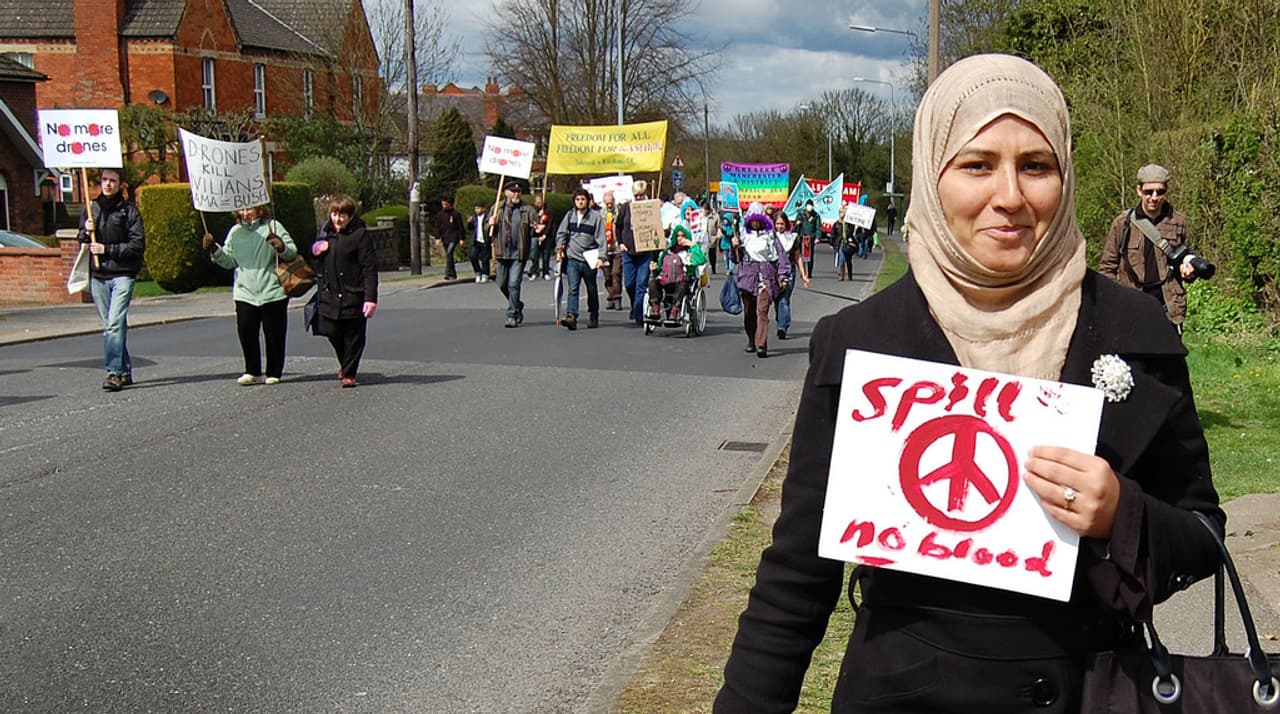
Protesters march against UK drones as MoD reveals ‘drone sharing’ with US
Groups including the Campaign for Nuclear Disarmament and War on Want joined the march. (Photo: Sarah Baldwin)
An estimated 600 campaigners staged a march and rally at a Lincolnshire air base this weekend protesting at the opening of the UK’s first military base for remote armed drone operations.
Protesters marched four miles from Lincoln to RAF Waddington. Last week the Ministry of Defence (MoD) confirmed that drone flights in Afghanistan are already being piloted from the air base.
The march took place as the government admitted that Royal Air Force crews have carried out more than 2,000 missions using ‘borrowed’ US armed drones. These are on top of hundreds of missions carried out by the RAF’s own Reaper drone fleet in Afghanistan.
The news prompted Conservative MP Rehman Chishti to warn that armed drone operations in Afghanistan by the RAF and the United States Air Force have become so interchangeable that Britain ‘may no longer be able to determine accountability and responsibility if civilians are killed’.
‘Normalised’
Protest group Stop the War described Saturday’s demonstration at RAF Waddington as the first public protest in the UK against armed drones being controlled from Britain.
Spokesman Ian Chamberlain told the Bureau: ‘There’s something morally repulsive about the idea that in Lincolnshire someone can press a button and kill in Afghanistan.’
Since 2008, RAF crews have remotely-piloted Britain’s small armed drones fleet from Creech Air Force Base in Nevada. The additional facility at Waddington will allow the RAF to operate more efficiently, according to the Ministry of Defence.
‘The opening of this new drone warfare centre has brought home to many people that the use of drones by British forces is not after all, temporary and time-limited. Rather the use of drones to launch “risk-free” airstrikes at great distances is being normalised,’ said Chris Cole of Drone Wars UK.
Defence minister Andrew Robathan also revealed last week that British military personnel have been directly embedding with the US Air Force, flying combat drone sorties in the recent Libyan and Iraq wars, as well as in Afghanistan. These ’embeds’ last for up to three years with ‘fewer than 10 pilots’ embedded at any one time, an MoD spokesman told the Bureau.
Rehman Chishti, Conservative MP for Gillingham and Rainham, said he was ‘surprised and astonished’ by the minister’s answers which he says make it difficult to understand where accountability for armed drone strikes now lies.
‘The problem with embedding British pilots with the Americans, for example, is that you can no longer determine responsibility,’ Chisti told the Bureau. ‘This muddies the waters completely, risks turning the people of Afghanistan against us, and creates a joint liability for both the UK and US governments.’
Interlocking forces
Britain is the only nation Washington has so far allowed to purchase and operate armed MQ-9 Reaper drones. UK-badged combat missions began in Afghanistan in late 2008. Yet for some years beforehand, British pilots and analysts were flying US drones under the embedding programme. An MoD spokesman said UK drone pilots follow British rules of engagement even when embedded with the US military.
Operations by RAF and USAF Reapers have now become so interchangeable in Afghanistan that it may no longer be possible to distinguish between the two. News that British crews are flying US armed drones may also help to explain anomalies that have been puzzling drone analysts.
Two apparent anomalies are the high proportion of missiles reportedly fired by UK pilots, and the low numbers of RAF-declared civilian casualties when compared to other recent conflicts.
Last autumn Britain announced it is doubling the size of its fleet of Reapers in Afghanistan from five to ten aircraft. The US Air Force is believed to operate as many as 200 armed drones in Afghanistan, although a spokeswoman declined to provide figures.
Yet data released last year to the Bureau by Centcom, which oversees coalition operations in Afghanistan, indicated that British crews fired at least one in five of all missiles fired by drones in the country in 2012. Neither Centcom nor the Ministry of Defence (MoD) in London could explain that high figure.
News that many of these missiles may have been fired from US-badged drones could help explain the discrepancy.

There remains no official, systematic account of how many people are killed by drones in Afghanistan, and their identities. Centcom routinely declines to provide any casualty data for Afghanistan drone strikes, though Britain has been slightly more forthcoming. David Cameron told reporters in 2010 that UK drones had killed ‘more than 124 insurgents’, and the MoD has also admitted to four civilian deaths. The UN mission in Afghanistan reported that 16 civilians died in drone strikes in 2012 alone, but in the absence of official estimates from the US and UK, it is impossible to tell who was responsible.
This week defence minister Andrew Robathan also confirmed British pilots have flown drone combat missions in both Libya and Iraq – conflicts in which no UK-badged armed drones participated. Between 2006 and 2012, UK crews flew 2,150 missions in US-owned drones in Afghanistan and Libya, according to Robathan – a small but significant portion of total drone missions in those theatres.
Data on Coalition drone usage only spans back to 2008, but this shows drones flew around 36,500 armed missions in total in Afghanistan and Libya between 2008 and October 31 2012. Of these, around one in thirty resulted in a drone strike.
Centcom recently stopped publishing statistics on armed drone activity in Afghanistan, saying they ‘disproportionately focused’ on the role played by unmanned aircraft. Before the figures were effectively reclassified, they illustrated the rapid rise of the drone in conventional wars. In 2009, drones fired around one in 20 of all missiles released by Coalition aircraft. By January 2013, this had risen to one in five.


